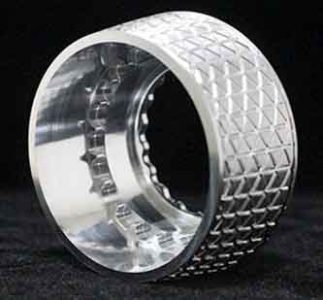Existem muitas razões para a deformação de peças de liga de alumínio durante a usinagem CNC, e o método de operação também é uma das razões na operação real. Próximo, o fabricante de usinagem CNC de peças de liga de alumínio apresentará brevemente as habilidades operacionais de processamento de peças de liga de alumínio.
(1) For parts with large milling allowances, in order to have better heat dissipation conditions during processing and avoid heat concentration, symmetrical processing should be used during processing. Se houver uma folha de alumínio com 90 mm de espessura que precise ser usinada em 60 mm, if the other side is milled immediately after milling all the margins on one side, and the final size is processed at one time, the flatness can only reach 5mm; If symmetrical processing with repeated feeds on two sides is used, each side is processed twice to the final size, which can ensure a flatness of 0.3mm.
(2) Reduce cutting force and cutting heat by changing the cutting amount. Among the three elements of cutting volume, cutting thickness has a great influence on cutting force. If the milling allowance is too large, the cutting force of one pass is too large, which will not only deform the parts, but also affect the rigidity of the machine tool spindle and reduce the durability of the tool. If the cutting thickness is reduced, the production efficiency will be greatly reduced. No entanto, high-speed milling is used in CNC machining, which can overcome this problem. While reducing the cutting thickness, as long as the feed is increased correspondingly and the speed of the machine tool is increased, the cutting force can be reduced while ensuring the processing efficiency.
(3) If there are multiple cavities on the aluminum plate part, it is not advisable to use a cavity-by-cavity sequential processing method during processing, as this will easily cause uneven stress and deformation of the parts. Multi-layer processing is adopted, and each layer is processed to all cavities at the same time as much as possible, and then the next layer is processed to make the parts evenly stressed and reduce deformation.
4) The thin-walled aluminum alloy workpiece is deformed due to the clamping of the fixture during CNC machining. Even finishing is unavoidable. In order to minimize the deformation of the workpiece, you can loosen the clamp before the finishing process reaches the final size, so that the workpiece can be restored to its original shape freely. Then lightly compress it to the extent that it can just clamp the workpiece, so that the ideal processing effect can be obtained. Resumidamente, the point of action of the clamping force is best on the supporting surface, and the clamping force should act in the direction where the rigidity of the workpiece is good. Under the premise of ensuring that the workpiece does not loosen, the smaller the clamping force, the better.
(5) The CNC cutting sequence should also be paid attention to. Rough machining emphasizes the improvement of machining efficiency and the pursuit of removal rate per unit time. Rough machining can generally be upside milling. Aquilo é, the excess material on the surface of the blank is removed at the fastest speed and the shortest time, and the geometric contour required for finishing is basically formed. The emphasis of finishing is high precision and high quality, so down milling should be used. Because the cutting thickness of the cutter teeth gradually decreases from the maximum to zero during down milling, the degree of work hardening is greatly reduced, e ao mesmo tempo, the degree of deformation of the parts is reduced.
(6) When CNC machining aluminum parts with cavities, try not to let the milling cutter plunge directly into the part like a drill. This leads to insufficient chip holding space of the milling cutter, unsmooth chip removal, and unfavorable phenomena such as parts overheating, expansion, tool collapse, and tool breakage. Primeiro, drill the hole with a milling cutter of the same size as the milling cutter or one size larger, and then use the milling cutter to mill. Alternatively, the CAM software can be used to produce the spiral cutting program.

Habilidades de torneamento e fresamento de peças de liga de alumínio
 English
English العربية
العربية 中文(漢字)
中文(漢字) Čeština
Čeština Dansk
Dansk Nederlands
Nederlands Suomi
Suomi Français
Français Deutsch
Deutsch Italiano
Italiano 日本語
日本語 ಕನ್ನಡ
ಕನ್ನಡ 한국어
한국어 Português
Português Русский
Русский Slovenčina
Slovenčina Español
Español Svenska
Svenska Türkçe
Türkçe

